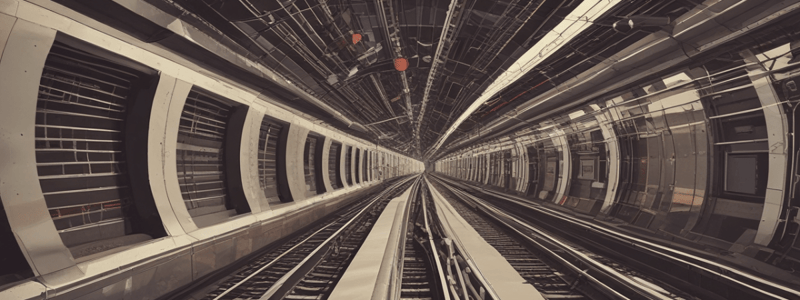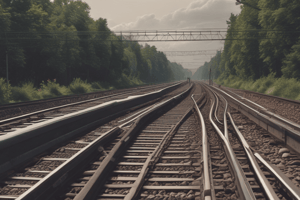Podcast
Questions and Answers
What is the purpose of marking the gauge face of the outer rail at a distance of at least 30 m behind the beginning of the curve?
What is the purpose of marking the gauge face of the outer rail at a distance of at least 30 m behind the beginning of the curve?
- To determine the revised alignment of the curve
- To ensure inclusion of the point of commencement of the curve (correct)
- To measure the versine readings along the gauge face of the outer rail
- To compute the slews including provision of correct super-elevation
At what interval should the stations be marked on the rail if station markings are not available at every 10 m interval?
At what interval should the stations be marked on the rail if station markings are not available at every 10 m interval?
- Every 10 m interval (correct)
- Every 5 m interval
- Every 20 m interval
- Every 30 m interval
What is the accuracy level at which the versines are measured?
What is the accuracy level at which the versines are measured?
- 5 mm
- 0.5 mm
- 1 mm (correct)
- 0.1 mm
What is the purpose of the fishing cord or wire in the versine survey?
What is the purpose of the fishing cord or wire in the versine survey?
Where should the mark be made on the gauge face of the outer rail at the beginning of the curve?
Where should the mark be made on the gauge face of the outer rail at the beginning of the curve?
What is the purpose of operation No. 1 in string lining operations?
What is the purpose of operation No. 1 in string lining operations?
What is the criteria for realignment of a curve based on service limit for station to station versine variation?
What is the criteria for realignment of a curve based on service limit for station to station versine variation?
How should the 'stations' be marked on the rail?
How should the 'stations' be marked on the rail?
What is the unit of cant, as per the given content?
What is the unit of cant, as per the given content?
What is the maximum cant allowed on Broad Gauge Group 'A', 'B', and 'C' routes?
What is the maximum cant allowed on Broad Gauge Group 'A', 'B', and 'C' routes?
For what purpose is a maximum cant of 185 mm assumed on Group 'A' routes?
For what purpose is a maximum cant of 185 mm assumed on Group 'A' routes?
Who needs to approve changes to the super-elevation of a line?
Who needs to approve changes to the super-elevation of a line?
What is the maximum value of cant deficiency allowed on routes with sectional speed more than 100 Kmph?
What is the maximum value of cant deficiency allowed on routes with sectional speed more than 100 Kmph?
Why should cant excess be kept low on sections carrying predominantly goods traffic?
Why should cant excess be kept low on sections carrying predominantly goods traffic?
What is the formula for calculating the length of transition 'L' in terms of cant excess 'Cd'?
What is the formula for calculating the length of transition 'L' in terms of cant excess 'Cd'?
What is the purpose of providing a transition length on a curve?
What is the purpose of providing a transition length on a curve?
What is the rail type used in subassembly 7?
What is the rail type used in subassembly 7?
What is the gradient of subassembly 3?
What is the gradient of subassembly 3?
What type of sleeper is used in all subassemblies?
What type of sleeper is used in all subassemblies?
What is the purpose of SEJs in LWR?
What is the purpose of SEJs in LWR?
What is the rail type used in subassembly 1?
What is the rail type used in subassembly 1?
What type of web switch is used in subassembly 9?
What type of web switch is used in subassembly 9?
What is common to subassemblies 10 and 11?
What is common to subassemblies 10 and 11?
What is the purpose of turnouts in LWR?
What is the purpose of turnouts in LWR?
What type of expenditure is mentioned in the context of removing restrictions to slewing?
What type of expenditure is mentioned in the context of removing restrictions to slewing?
What is the purpose of measuring and recording the existing Super-elevation?
What is the purpose of measuring and recording the existing Super-elevation?
What is the format of the record obtained from the survey?
What is the format of the record obtained from the survey?
What is indicated by the 'Remarks' column in the record?
What is indicated by the 'Remarks' column in the record?
Why is the versine survey continuous in the case of reverse curves?
Why is the versine survey continuous in the case of reverse curves?
What is the purpose of recording the features that restrict slewing of the track?
What is the purpose of recording the features that restrict slewing of the track?
What is indicated by the 'Versine' column in the record?
What is indicated by the 'Versine' column in the record?
What is the significance of the 'G B obligatory point' remark in the record?
What is the significance of the 'G B obligatory point' remark in the record?
What is the pattern of spacing observed in the table?
What is the pattern of spacing observed in the table?
What is the value of the cumulative spacing from SRJ at row 14?
What is the value of the cumulative spacing from SRJ at row 14?
What is the purpose of the annexure pages in the document?
What is the purpose of the annexure pages in the document?
What is the significance of the value 600 in the table?
What is the significance of the value 600 in the table?
What is the relationship between the spacing and the cumulative spacing from SRJ?
What is the relationship between the spacing and the cumulative spacing from SRJ?
What is the unit of measurement for the spacing and cumulative spacing from SRJ?
What is the unit of measurement for the spacing and cumulative spacing from SRJ?
What is the purpose of the table?
What is the purpose of the table?
What is the significance of the rows in the table?
What is the significance of the rows in the table?
Flashcards are hidden until you start studying
Study Notes
Cant and Super-elevation
- Cant should be rounded off to the multiple of 5 mm.
- Maximum cant on curved tracks:
- Broad gauge - Group 'A', 'B', and 'C' routes: 165 mm
- Broad gauge - Group 'D' and 'E' routes: 140 mm
- Maximum cant deficiency:
- Routes with sectional speed over 100 km/h: 100 mm
- Other Broad gauge routes: 75 mm
- Cant excess should not exceed 75 mm for all types of rolling stock.
Length of Transition Curve and Setting-out Transitions
- The desirable length of transition 'L' shall be the maximum of three values:
- L = 0.008 Ca × Vm
- L = 0.008 Cd × Vm
- L = 0.72 × Ca
- Criteria for realignment of a curve based on service limit for station-to-station versine variation.
String Lining Operations
- Operations involve:
- Survey of the existing curve by measurement of versines
- Determination of the revised alignment and computation of slews, including provision of correct Super-elevation
- Slewing of the curve to the revised alignment
- Versine survey of curve:
- Versine readings are taken along the gauge face of the outer rail
- Markings are made on the gauge face of the outer rail at a distance of at least 30 m behind the beginning of the curve and at the end of the curve
- Stations are marked and numbered in white paint on the rail
- Versines are measured to 1 mm accuracy serially at each station from one end of the curve to the other
- Certain features that restrict slewing of the track are recorded
- Existing Super-elevation is measured and recorded against each station
LWR through Points and Crossings
- Turnouts shall be isolated from LWR/CWR by provision of SEJs on either side.
Rails and Switches
- Various types of rails and switches are listed with their respective characteristics and specifications.
Studying That Suits You
Use AI to generate personalized quizzes and flashcards to suit your learning preferences.




